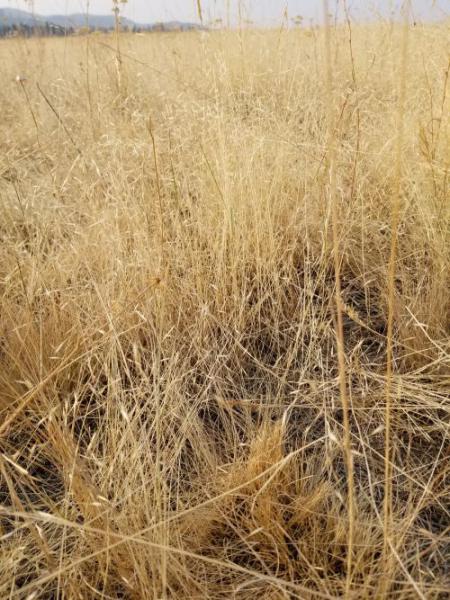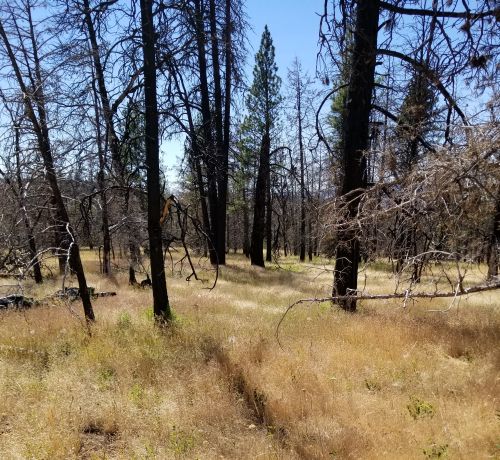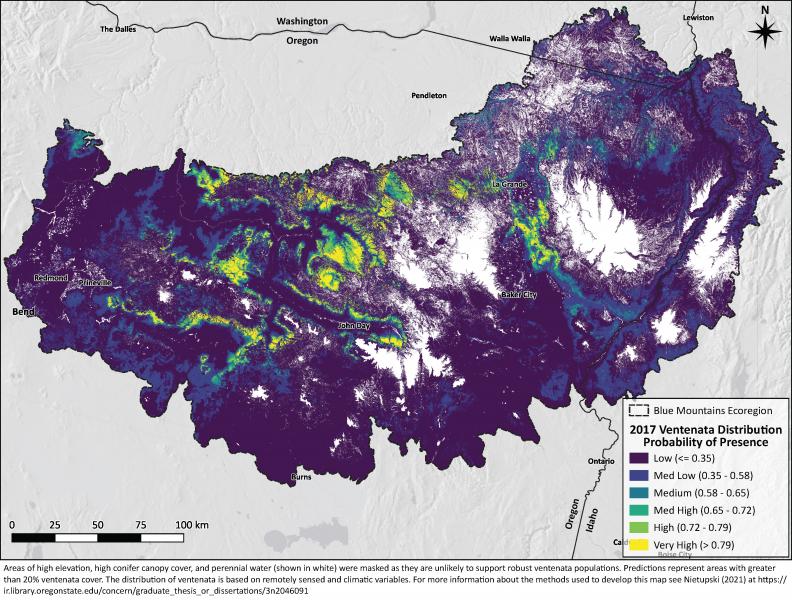Ventenata Invasion in the Blue Mountains Ecoregion
Watch the webinar on this project from March 2022: Invasion, Fire, and the Future of NW Wildlands Ventenata dubia in the Blue Mountains Ecoregion
Project overview:
Exotic plant invasions are a growing challenge to ecosystem management and are particularly dramatic when they alter disturbance regimes beyond the range of natural variation. A relatively new invasive annual grass, ventenata (Ventenata dubia) thrives at higher elevations, threatening biodiversity and creating ecosystem-level changes. We conducted landscape and regional scale research focused on the Blue Mountain Ecoregion (BME) in the Pacific Northwest to examine the extent of ventenata invasion and associated ecosystem change.
Ventenata was first reported in North America in 1952 in Washington and has since spread to many other western states. Ventenata is an increasing concern for both public and private land managers for a variety of reasons. Like other exotic invasive annual grasses, it is aggressive and can dominate large areas across the landscape. The plant dries earlier in the summer than native species and remains highly flammable throughout the fire season creating dangerous conditions on the ground. Land managers have noted that ventenata has increased and spread over the past decade in mountain meadows and scablands of the Blue Mountain Ecoregion but the full extent of ventenata invasion was unknown prior to our research efforts.
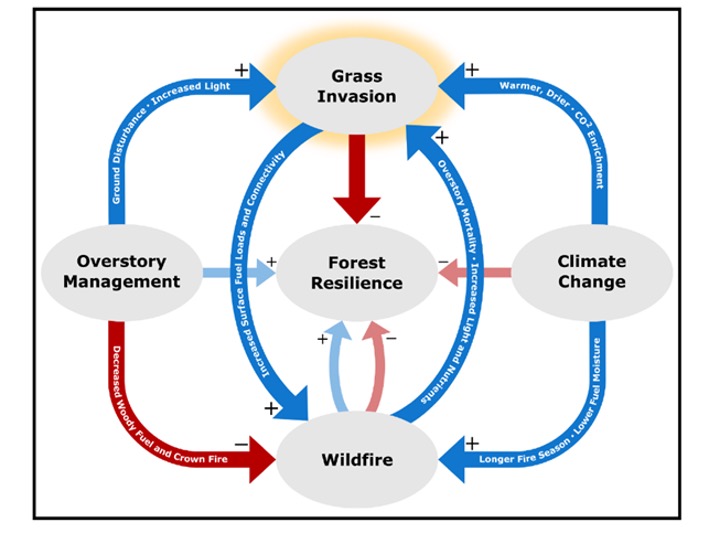 Forests may be surprisingly more vulnerable to grass invasion than conventional wisdom might suggest, and climate change, wildfire, and the unintended consequences of overstory management may increase invasion risk for forests. New research is documenting the extent to which these species could catalyze rapid and novel change and reduce resilience in forested ecosystems worldwide. From Kerns et al. 2020.
Forests may be surprisingly more vulnerable to grass invasion than conventional wisdom might suggest, and climate change, wildfire, and the unintended consequences of overstory management may increase invasion risk for forests. New research is documenting the extent to which these species could catalyze rapid and novel change and reduce resilience in forested ecosystems worldwide. From Kerns et al. 2020.
The research project had four primary objectives, outlined below:
|
|
|
3. Scablands |
|
Ventenata Occurrence in the BME
Ventenata occurrence probability (>20% cover) in the ecoregion based on model predictions. This map was created using field data, remotely sensed landscape scale phenology metrics (Nietupski et al. 2021), soil texture data, and climatic variables (PRISM). Additional details are described in Nietupski 2021. Spatial data can be provided, please contact (becky.kerns@usda.gov or nietupst@oregonstate.edu).
 The mean percent-change in ventenata probability for wildfire and non-wildfire areas (median; 25th and 75th percentile are the upper and lower hinges, and the 5th and 95th percentile are the whiskers). From Nietupski et al. 2021.
The mean percent-change in ventenata probability for wildfire and non-wildfire areas (median; 25th and 75th percentile are the upper and lower hinges, and the 5th and 95th percentile are the whiskers). From Nietupski et al. 2021.
 Comparison of invasive annual grass species (Bromus tectorum (cheatgrass), Taeniatherum caput-medusae (medusahead), and Ventenata dubia(ventenata)) and their environmental characteristics across sample plots in the Blue Mountains Ecoregion (NMDS ordination, Tortorelli et. al 2020).
Comparison of invasive annual grass species (Bromus tectorum (cheatgrass), Taeniatherum caput-medusae (medusahead), and Ventenata dubia(ventenata)) and their environmental characteristics across sample plots in the Blue Mountains Ecoregion (NMDS ordination, Tortorelli et. al 2020). Ventenata invades areas across a wide range of understory and canopy cover, but the most heavily invaded areas were burned with <50% herbaceous cover and <20% canopy cover. Burning intensified negative relationships between ventenata cover and native species richness, annual forb cover, annual grass cover, and non-native species cover.
Overall, our results indicate that ventenata is heavily invading previously uninvaded vegetation types. This conclusion is also supported by our mapping results. The ventenata invasion is expanding the annual grass invasion footprint and potential impacts in the ecoregion, not just coexisting with other annual grasses or replacing them.
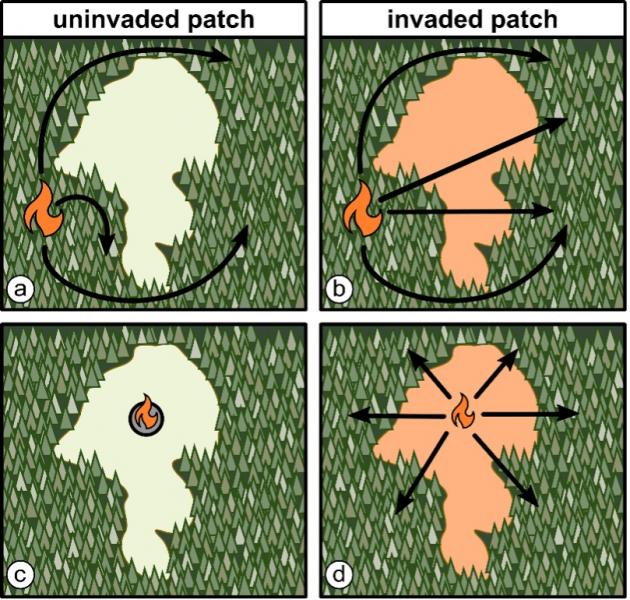 Figure: Predicted differences in fire spread between non-forest patches and the surrounding forest for an invaded and uninvaded scenario. Panels (a) and (b) illustrate differences in fire spread when a fire is ignited in the forest and travels either (a) around the uninvaded patch or (b) across the invaded patch into the adjacent forest. Panels (c) and (d) illustrate fire behavior differences when a fire is ignited within the patch. (c) Fire fails to spread into the surrounding forest because the uninvaded patch lacks a continuous fuel bed. (d) Fire readily spreads across invaded patch and into surrounding forest. From: Tortorelli et al. in review.
Figure: Predicted differences in fire spread between non-forest patches and the surrounding forest for an invaded and uninvaded scenario. Panels (a) and (b) illustrate differences in fire spread when a fire is ignited in the forest and travels either (a) around the uninvaded patch or (b) across the invaded patch into the adjacent forest. Panels (c) and (d) illustrate fire behavior differences when a fire is ignited within the patch. (c) Fire fails to spread into the surrounding forest because the uninvaded patch lacks a continuous fuel bed. (d) Fire readily spreads across invaded patch and into surrounding forest. From: Tortorelli et al. in review.
We are also using a fire model called FSim Large Fire Simulator to explore how the ventenata invasion may change fire behavior under future climate scenarios and to address our last research objective. The fire simulations use future climate projections obtained from an ensemble of global climate models (GCMs). A key input variable into FSim is the energy release component (ERC), which represents fuel conditions, and has been shown to correlate strongly with both observed and simulated fire activity at broad scales. The majority of GCMs project increases in ERC throughout the spring, summer, and fall relative to ERC obtained from observations at a local (Allison RAWS) weather station in the study area, serving as the benchmark weather station.
 Monthly averages of energy release component (ERC) for Allison RAWS (benchmark present day weather observed), and mid- and end-century (2035-2064 and 2070-2099 respectively) projections based on 28 global climate models (GCMs). The dominant pattern of increased ERC during the spring, summer and fall suggests that the ecoregion will likely have more ignitions and fire spread, resulting in generally increased burn probabilities across the landscape. However, a few GCMs show small decreases in ERC especially for the mid-century, although this pattern is not as common by the end of the century.
Monthly averages of energy release component (ERC) for Allison RAWS (benchmark present day weather observed), and mid- and end-century (2035-2064 and 2070-2099 respectively) projections based on 28 global climate models (GCMs). The dominant pattern of increased ERC during the spring, summer and fall suggests that the ecoregion will likely have more ignitions and fire spread, resulting in generally increased burn probabilities across the landscape. However, a few GCMs show small decreases in ERC especially for the mid-century, although this pattern is not as common by the end of the century.













